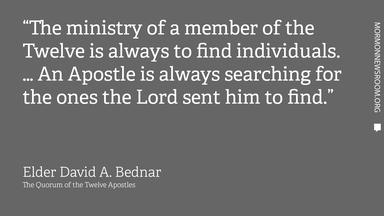
Look around the room on any given Sunday in a Latter-day Saint chapel and you'll soon realize you're among a heterogeneous group. Granted, some congregations might look more homogeneous based only on skin color or the number of dark suits and white shirts present. But look closer, with the right lenses, and you'll notice something else.
You might see a 20-something mother of two, exhausted by the demands of parenting young children alone due to a recent divorce. Or a single woman in her 50s who never married and struggles to connect with the everyday challenges and experiences of the fathers and mothers around her. Or a refugee finding his footing in a new country with a frightening foreign language and insufficient employment prospects.
A Shared Struggle
These examples are not unique to The Church of Jesus Christ of Latter-day Saints. Many faiths grapple with the challenge of how to best speak to everyone’s needs, and their leaders’ insights are worth noting.
In the Jewish tradition, Rabbi Jonathan Sacks has said showing love and concern for everyone equally is critical, challenging and, if not done correctly, dangerous. "Love is not unproblematic," he says. "Given to one but not another, to one more than another, it creates tensions. … Love is necessary but not sufficient. You also need sensitivity to those who feel unloved."[1]
In the evangelical tradition, Russell Moore of the Southern Baptist Convention has said faith leaders should be "connected enough [with congregants] to prophesy to those who need to hear. We need to be those who know both how to warn and to welcome."[2]
And for Catholicism, Pope Francis has spoken of the need to "be tender" with anyone who feels like an outsider and to not push them away because, simply put, "people are suffering." It's this kind of compassion that he says can "conquer the globalization of indifference."[3]
So how does The Church of Jesus Christ of Latter-day Saints—a faith of 15 million people—speak lovingly and inclusively to a membership of innumerable diverse personalities, perspectives and circumstances?
Offering ‘Something for Everyone’

Latter-day Saints worship an omniscient God who brings people closer to Him by drawing them closer to each other through worship and service. At the local level, members have weekly opportunities to speak from the pulpit and teach in the classroom. They are encouraged to share how the teachings of Jesus Christ impact their own lives, while those in the classroom audience can raise their hands and engage in dialogue about their own experiences.
Outside of Sunday services, members are encouraged to meet monthly with an assigned set of families or individuals. Known internally as home and visiting teaching, these visits are another opportunity for members to talk about Jesus and strengthen friendships. Or, as a Book of Mormon verse puts it, "to speak one with another concerning the welfare of their souls."[4]
At the general level, leaders are individual focused as well, even as they speak broadly to all members and oversee a global institution. The Church holds semiannual general conferences—worldwide broadcasts directed toward all Church members (though the advent of technology casts the net wider to anyone around the world interested in listening). To more effectively speak to a broad membership in these settings, leader addresses are often principle based.
"We always stress the eternal verities of faith, hope, charity, and Christ crucified even as we speak forthrightly on very specific moral issues of the day," Elder Jeffrey R. Holland has said. "We are commanded in the scriptures to 'say nothing but repentance unto this generation,' while at the same time we are to preach 'good tidings [to] the meek … [and] bind up the brokenhearted.' Whatever form they take, these conference messages 'proclaim liberty to the captives' and declare 'the unsearchable riches of Christ.'"
A brief look at the topics of any given general conference illustrates Elder Holland's comment. The April 2016 general conference touched on adversity, compassion, courage, forgiveness, faith, family, hope, love, joy, marriage, patience, prayer, self-control and a host of other subjects.
"In the wide variety of sermons given is the assumption that there will be something for everyone," Elder Holland says.
Reaching Out ‘One by One’

Latter-day Saint apostles also take a personal approach in their travels to meet with members around the world. Elder David A. Bednar has said the "ministry of a member of the [Quorum of the] Twelve [Apostles] is always to find individuals. … An Apostle is always searching for the ones the Lord sent him to find … to lift, to bless, to do something to help an individual or a family. When meeting with a group of members, of youth, or of young single adults, it is not that there is an audience of 1,500; there are 1,500 ‘ones.’”
Such an individual-focused approach was typical in the life of Jesus, and His example is ever the lodestar for everything Mormon leaders do. The New Testament is replete with example after example of the Savior healing and helping individuals.
A Book of Mormon phrase sums up well the Church's approach to reaching the hearts of individual members the world over. In a tender passage about Christ's love for children, the Book of Mormon says He "took their little children, one by one, and blessed them, and prayed unto the Father for them."[5]
Whether at the local or general level, speaking to the circumstances and hearts of every child, every parent, every person—one by one—is at the core of The Church of Jesus Christ of Latter-day Saints' mission.